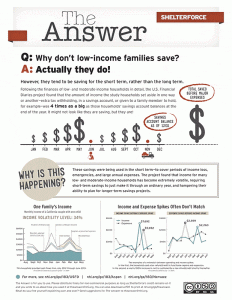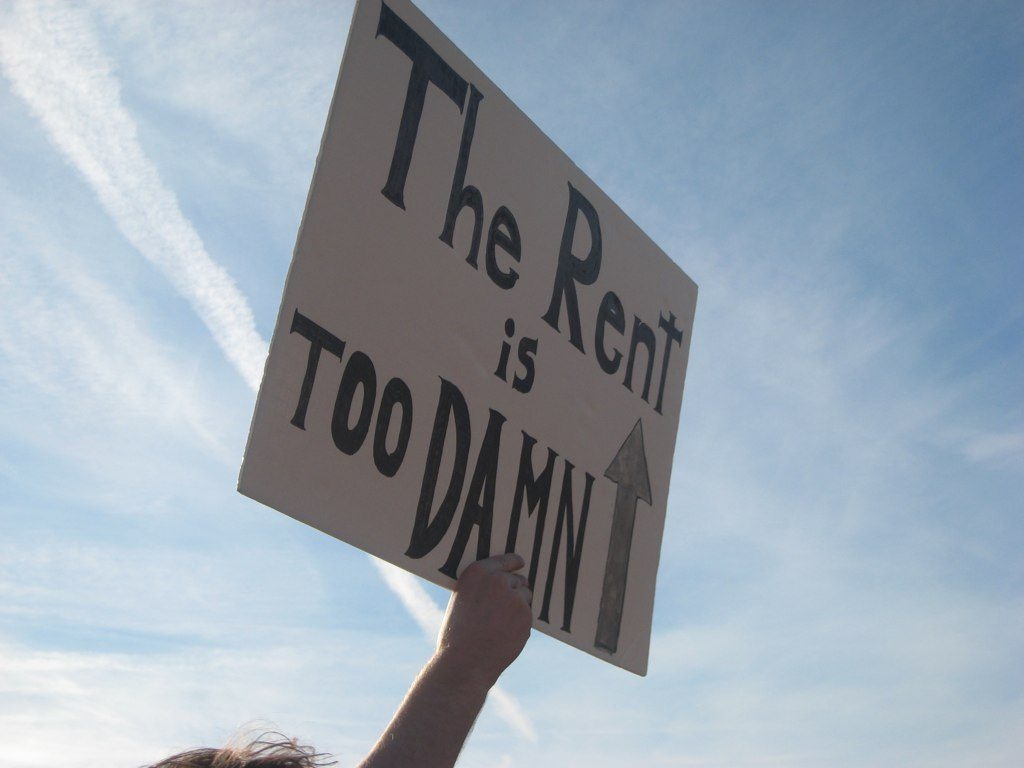Quote of the Week:
“Even as the core problem in cities shifted from disinvestment to displacement, the policy paradigm has remained the same: Spur growth in an area starved for investment, then redirect a limited portion of the resulting profit toward affordable housing. . . . To address displacement, policymakers must move beyond a 1980s paradigm that prioritizes growth above all else.”
—from Next City’s ”Addressing Displacement in the New York Metro Region Requires New Strategies”

Photo by Grace C. via flickr, CC BY-NC 2.0
While the rest of the country agrees that the rent is too high, HUD apparently thinks it’s too low—at least for people receiving rental assistance. A leaked memo obtained by CityLab proposes raising the rent for assisted tenants to 35 percent of their income instead of 30 percent (which is arguably already too high for very low-income folks). The mind-bogglingly out-of-touch memo also suggests instituting minimum rents and full-time work requirements for public housing. Basically HUD thinks there aren’t enough homeless. CityLab has the shameful details.
The tenants rights group Inquilinxs Unidxs in Minneapolis launched a rent strike just before Super Bowl weekend, contrasting the excesses of the game with the challenges of families struggling through a Minnesota winter without heat or facing other “slum conditions.” We know who we’re rooting for.
https://twitter.com/jiwinkler/status/958836065762201600
You’re not imagining it: The rent is really that high. Trulia reports that average rents increased 3.1 percent last year, with places as disparate as Los Angeles, Tacoma, and Milwaukee experiencing jumps over 8 percent. But it’s even more notable that since the end of the Great Recession in 2012, rent have risen 19.6 percent nationally, and in a few places, including Cape Coral-Fort Myers, Florida, and Oakland, California, that jump has been 50 percent.
It wasn’t a great week for the Consumer Financial Protection Bureau. It started off on a positive note when the Court of Appeals reversed its previous decision and ruled that the CFPB’s leadership structure was indeed constitutional. But then, the proverbial crap hit the fan. CFPB Director Mick Mulvaney stripped enforcement powers from the office that worked on lending discrimination cases, according to The Washington Post. “That unit now will move inside the office of the director, where staffers will be focused on ‘advocacy, coordination and education,’” the Post reported. “Mulvaney said the CFPB would still look to protect consumers but would not try to ‘push the envelope.’” Thanks for turning a blind eye on lending discrimination, Mulvaney. We can’t say we’re surprised.
In some “Good News/Bad News,” Grounded Solution’s Emily Thaden detailed a win for shared-equity homeownership in a recent Shelterforce post. In short, the win was a commitment from Fannie Mae and Freddie Mac to increase access to affordable mortgages for shared-equity (and lower-income) borrowers as part of their Underserved Markets Plans under the implementation of the Federal Housing Finance Agency’s Duty to Serve program. However, a newly proposed bipartisan bill to overhaul the U.S. mortgage finance system could potentially undermine that effort. Proponents of the bill tout its plan to increase lower-income mortgage lending and devote several billion dollars a year toward subsidies for affordable housing construction. Detractors say, above all, that it seeks to get the federal government (and its stated commitment to lower-income homeownership) out of the mortgage financing business. The bill currently removes requirements on banks to make a certain number of home loans to lower-income borrowers, and allows banks to base loan rates on individual risk. The bill contains yet-to-be-filled holes, and will need Democrat votes in order to pass. There will likely be changes and concessions on both sides if that happens, and we’ll be watching.
We spent years battling the assertion that the foreclosure crisis and the Great Recession were caused by poor homebuyers who borrowed above their means, rather than predatory loans with misleading and damaging terms, and predatory and irresponsible Wall Street shenanigans that profited off of them. So it was with no small amusement (of the dark humor sort) that we discovered that the poor mortgage industry feels it was (and still is being) blamed unfairly for the mess by a biased press. Aww. We’re playing a super tiny violin made out of wrongful foreclosure filings for you guys.

Photo by Matt Madd via flickr, CC BY-NC-ND 2.0
If you’ve ever visited a city library, you know that they are a daytime refuge for the homeless. As the community spaces are open to the public, most libraries allow homeless individuals to use the facilities; but when individuals with mental illness cause disruption, staff must act. New training to help library staff manage these situations is underway in Sacramento, California. Not designed to diagnose or provide counseling, the training will help staff recognize signs and symptoms of mental illness, defuse potentially volatile situations, and reach out to outside professionals who can provide further care. According to the National Alliance on Mental Illness, an estimated 46 percent of unsheltered people live with some type of mental condition. It is encouraging to see the needle moving—albeit slowly—on the way we deal with mental illness as a culture; and hopefully situations that may have resulted in arrest in the past will now end in care. Libraries—and librarians—proving their immeasurable worth once again.
The Bay Area has come to be known for two things: its lack of affordable housing and its preponderance of tech startups. As we hear more and more about how Accessory Dwelling Units (dubbed “granny flats” by some) are being used and proposed in many regions as a tool to address their affordable housing shortages, it comes as no surprise that tech has entered the conversation. Homeowners in the Bay Area who seek to create or convert rental properties on their lots have had difficulty when trying to finance the often-expensive endeavor (upwards of $100,000). This new space, which large, risk-averse corporations have been hesitant to enter, is being filled by a few startup financing companies and affordable housing organizations. It won’t be long before this market has been proven, however, meaning big banks are not far behind (JP Morgan Chase has already dipped its toe).
Getting hospitals to care more about affordable housing might be a tough sell, but we’re seeing more and more instances of hospitals getting into the housing business, which is great. Hospitals are participating in pilot programs to house the homeless, and seeing positive results as health care costs are dropping for each patient housed. But we’re worried about two things. First off, hospitals shouldn’t focus too much on the cost savings (more on this in our latest health-focused issue of Shelterforce magazine, which comes out mid-February). Secondly, we want to make sure hospitals don’t reinvent the wheel. Hospitals must help increase the affordable housing supply because the issue isn’t that we don’t have enough housing for people, the issue is that there isn’t enough affordable and safe housing available.
Access to doctors and healthy homes is extremely important to a person’s well-being, but in Chicago, we’re seeing that we also must be concerned about areas that have limited access to pharmacies. Low-income, immigrant, Black, and Latino neighborhoods in the Windy City are losing pharmacies left and right and becoming pharmacy deserts, a growing health concern for residents. “The problem is worsening because of recent pharmacy closures in areas where there are transportation barriers,” according to the article.
States stepping up where the federal government is abdicating (see also: consumer protection) seems to be a bit of a trend. in the wake of federal tax reform that promises to widen income inequality, South Carolina has passed a state-level earned-income tax credit. Such a credit has been a goal of advocates there for years, and though it is a disappointment that the credit wasn’t refundable, it’s still positive step forward. Congrats to S.C.
Have you talked to your governor about the Investing in Opportunity Act? You should. The act is a small silver lining tucked into the tax reform bill that gives tax breaks for investments in “Opportunity Areas.” A National Development Council webinar on the topic described it as complement to the New Markets Tax Credits, but for equity investments instead of debt (the equity investments will have to made through certified funds). Enterprise has the details. But the time-sensitive part is that each governor has only 90 days from the passage of the bill (or actually until March 31st, or April 30th if they get an extension) to designate up to 25 percent of the census tracts deemed eligible for the program as Opportunity Zones. That’s a short time frame to come up with priorities—Will the zones chosen advance racial equity? Will they reward investment that really wouldn’t have happened otherwise?—but it might also mean some well-placed suggestions by those familiar with these neighborhoods might carry significant weight.
Is your mayor part of Mayors and CEOs for U.S. Housing Investment? CityLab has called the newly formed group possibly “the broadest campaign yet to fight the housing crisis.” We hope their ranks grow—and that they put protecting and expanding the National Housing Trust Fund on their agenda.







Comments